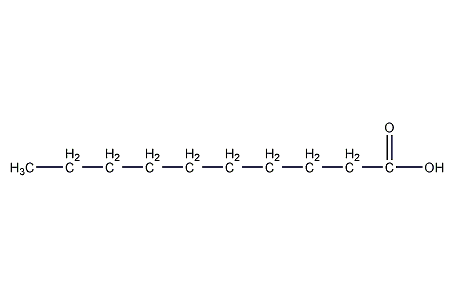
Structural formula
| Business number | 049Q |
|---|---|
| Molecular formula | C10H20O2 |
| Molecular weight | 172.26 |
| label |
caprylic acid, n-decanoic acid, Decanoic acid, Sheep wax acid, Kwai acid, 10 alkyl acid, n-Decanoic acid, capric acid, plasticizer, acidic solvent |
Numbering system
CAS number:334-48-5
MDL number:MFCD00004441
EINECS number:206-376-4
RTECS number:HD9100000
BRN number:1754556
PubChem number:24901019
Physical property data
1.Characteristics: Unpleasant white crystals.
2. Density (g/mL, 30℃): 0.8858
3. Relative density (20℃, 4℃): 0.9008d
4. Melting point (ºC):31.5 span>
5. Boiling point (ºC, normal pressure):270
6. Relative density (25℃, 4℃): 0.885840
7. Refractive index (40℃): 1.4286 span>
8. Solubility:Insoluble in water, soluble in most chemicals��In organic solvents and dilute nitric acid.
9. Refractive index at room temperature (n25): 1.428840
10. Refractive index at room temperature (n20): 1.4363d
11. Critical temperature (ºC): 448.85
12. Critical pressure (MPa): 2.10
13. Critical density (g·cm-3): 0.270
14. Critical volume (cm3·mol-1): 638
15. Critical compression factor: 0.223
16. Eccentricity factor: 0.877
17. Gas phase standard combustion heat (enthalpy) (kJ·mol-1): -6198.4
18. Gas phase standard claimed heat (enthalpy) (kJ·mol-1): -594.9
19. Liquid phase standard combustion heat (enthalpy) (kJ·mol -1):-6109.0
20. Liquid phase standard claimed heat (enthalpy) (kJ·mol-1): -684.3
21. Crystal phase standard combustion heat (enthalpy) (kJ·mol-1): -6079.6
22. Crystal phase standard claims heat (enthalpy) (kJ·mol-1): -713.7
23. Flash point (ºC): >110
Toxicological data
The oral LC50 of mice is greater than 10g/kg, but it has an irritating effect on the skin.
Ecological data
Other harmful effects: This substance has The environment may be hazardous and special attention should be paid to water bodies.
Molecular structure data
1. Molar refractive index: 49.94
2. Molar volume (cm3/mol): 188.2
3. Isotonic specific volume (90.2K ): 451.7
4. Surface tension (dyne/cm): 33.1
5. Polarizability (10-24cm3): 19.79
Compute chemical data
None yet
Properties and stability
1. It is a white solid at room temperature with an unpleasant odor. It is insoluble in water and soluble in ethanol and most organic solvents.
2.This product is non-toxic. The oral LC50 of mice is greater than 10g/kg, but it has a irritating effect on the skin.
3. Found in flue-cured tobacco leaves, burley tobacco leaves, and oriental tobacco leaves.
4. Naturally found in apples, beef, and wheat bread.
Storage method
Packed in aluminum drums, 100kg per drum. Store in a cool, ventilated and dry place, keep away from sources of fire and oxidants.
Synthesis method
1. Hydrolyze coconut oil, laurel oil, and Litsea cubeba oil to produce lauric acid, and at the same time capric acid is produced as a by-product, with a yield of 30% of lauric acid.
2. Tobacco: OR, 44, 49; BU, 56; OR, 26; FC, 9; FC, 15; FC, OR, 18; BU, 26; FC, 40. Prepared from octane bromide.
Purpose
1. Mainly used to prepare capric acid ester products. Its esters can be used as spices, wetting agents, plasticizers and food additives.
2.Mainly used as raw material for plastic plasticizers and cationic fungicides. Its fatty acid esters have a fruity aroma and are used as spices.


